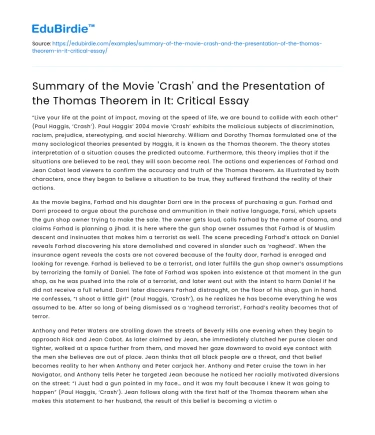“Live your life at the point of impact, moving at the speed of life, we are bound to collide with each other” (Paul Haggis, ‘Crash’). Paul Haggis’ 2004 movie ‘Crash’ exhibits the malicious subjects of discrimination, racism, prejudice, stereotyping, and social hierarchy. William and Dorothy Thomas formulated one of the many sociological theories presented by Haggis, it is known as the Thomas theorem. The theory states interpretation of a situation causes the predicted outcome. Furthermore, this theory implies that if the situations are believed to be real, they will soon become real. The actions and experiences of Farhad and Jean Cabot lead viewers to confirm the accuracy and truth of the Thomas theorem. As illustrated by both characters, once they began to believe a situation to be true, they suffered firsthand the reality of their actions.
As the movie begins, Farhad and his daughter Dorri are in the process of purchasing a gun. Farhad and Dorri proceed to argue about the purchase and ammunition in their native language, Farsi, which upsets the gun shop owner trying to make the sale. The owner gets loud, calls Farhad by the name of Osama, and claims Farhad is planning a jihad. It is here where the gun shop owner assumes that Farhad is of Muslim descent and insinuates that makes him a terrorist as well. The scene preceding Farhad’s attack on Daniel reveals Farhad discovering his store demolished and covered in slander such as ‘raghead’. When the insurance agent reveals the costs are not covered because of the faulty door, Farhad is enraged and looking for revenge. Farhad is believed to be a terrorist, and later fulfills the gun shop owner’s assumptions by terrorizing the family of Daniel. The fate of Farhad was spoken into existence at that moment in the gun shop, as he was pushed into the role of a terrorist, and later went out with the intent to harm Daniel if he did not receive a full refund. Dorri later discovers Farhad distraught, on the floor of his shop, gun in hand. He confesses, “I shoot a little girl” (Paul Haggis, ‘Crash’), as he realizes he has become everything he was assumed to be. After so long of being dismissed as a ‘raghead terrorist’, Farhad’s reality becomes that of terror.
Save your time!
We can take care of your essay
- Proper editing and formatting
- Free revision, title page, and bibliography
- Flexible prices and money-back guarantee
Anthony and Peter Waters are strolling down the streets of Beverly Hills one evening when they begin to approach Rick and Jean Cabot. As later claimed by Jean, she immediately clutched her purse closer and tighter, walked at a space further from them, and moved her gaze downward to avoid eye contact with the men she believes are out of place. Jean thinks that all black people are a threat, and that belief becomes reality to her when Anthony and Peter carjack her. Anthony and Peter cruise the town in her Navigator, and Anthony tells Peter he targeted Jean because he noticed her racially motivated diversions on the street: “I Just had a gun pointed in my face… and it was my fault because I knew it was going to happen” (Paul Haggis, ‘Crash’). Jean follows along with the first half of the Thomas theorem when she makes this statement to her husband, the result of this belief is becoming a victim of carjacking by the very people she believed would.
‘Crash’ presents the impact of discrimination and social titles on everyone in society. It shows viewers that every single one of your actions has a reaction, whether it be from yourself or the people around you. The takeaway of this film should be the ability to reanalyze attitudes and behavior towards others, as you never really know what anyone else is thinking. The situations faced by Jean and Farhad could have been avoided if people were not raised with a racist outlook on the world.






 Stuck on your essay?
Stuck on your essay?

